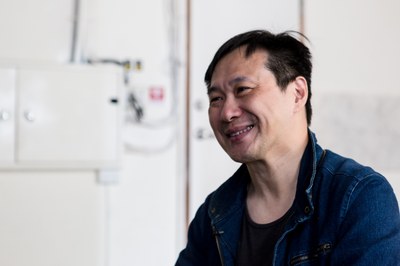
攝影| 陳藝堂
關於生之重力的間奏式──第十屆第六種官能表演藝術祭.台灣-韓國匯演
身體氣象館
首演日期│2016/12/28
首演地點│牯嶺街小劇場
入圍理由
作品導演姚立群與三位台灣—韓國身障表演者(鄭志忠、李新寶、姜聲國),以及劇場演員黃志勇、鋼琴樂手黃柔閩,共同完成的演出;可說是一次眾多生命以各自存在樣貌於「劇場」此場域交互匯流的行動過程。 從開演前要求觀眾入場自報名字的設計,開始聲息相通的觀演過程,同時反轉傳統觀演關係的權力位置;表演文本返回身體本質動能的發散與淬煉,面對不協調的生之慾望與衝突、生命的殘酷與美好,彰顯、放大諸多心理感官細節,觀/演一起呼吸、喘息、顫慄、頌讚:ㄧ場迸發無以名之強勁力量的肉身展演。(主筆/楊美英)
關於關於生之重力的間奏式──第十屆第六種官能表演藝術祭.台灣-韓國匯演
《關於生之重力的間奏式》三位主要演員形象所蘊含的社會意涵,牢牢附著在他們真實的身體上:姜聲國來自韓國,因腦性麻痺而肢體無法自主靜制;鄭志忠自小罹患小兒麻痺而雙腳萎縮;而李新寶於成年後步上全盲的生涯,且近幾年因交通事故導致右腳踝粉碎性骨折暨左小腿骨裂。整體來理解他們的日常,似乎這活生生的人間世大多數人的慾望也罕能參與進來。由於身心的狀態,真實的生活中,他們擁有相對較短的夜。一來,劇場可以成為一種想像的公共空間,讓他們接觸,讓孤獨與孤獨的接觸,看看從兩兩「(難以)協調」展開,不斷變換、轉化,能夠構成如何的「風景」。同時,不迴避劇場成了一處窺視的場域,讓演員們與觀眾之間去辯證孤獨的樣貌與概念─孤獨者的沉溺與抵抗。
關於人物
《關於生之重力的間奏式》是第十屆「第六種官能表演藝術祭」的重要製作,由腦性麻痺、肢障、視障表演者的肉身動態所交織而成的演出。導演姚立群透過異質的情感傳遞,到異質的肢體碰撞、交涉與相互協調,企圖在劇場中提出融合、跨越障礙別的劇場敘事語彙。姚立群身兼牯嶺街小劇場館長與此作導演,跟身心障礙者合作已十多年,認為此次最大挑戰是讓不同障礙別的演員,擁有相對應的交流模式,協助演員找到彼此於舞台上的共存之道。他說:「即使是所謂身心無障礙的演員,也有不同的訓練背景,也要花時間磨合;更別說被劃類到身障者的表演者,他們身上的特殊性,必然要花大量時間去認識」。
演員總共五位,除了兩位非身障者的男女演員黃志勇與黃柔閩,另三位皆是具多年表演經驗的身障者。資深劇場演員兼導演鄭志忠(阿忠)是臺灣劇場界的指標人物,是姚立群的前輩,「阿忠已經做了三十年劇場,他對劇場的思索比一般人深,在台上的身體表演也很驚人」。他們倆在牯嶺街小劇場交往頗久,卻從不曾以導演與演員的身分合作過,姚立群笑說:「過去三年他協助我帶工作坊,發現他和盲人共事的可能,才敢大膽邀他演出」。許多年輕觀眾也許不知鄭志忠其人其事,無法想像不靠雙腳的他如何演戲,他說:「也算風華再現吧!觀眾看他演戲應該會有很大的認知衝擊,或產生理解上的破口,重新思考舞台上的『存在感』」。
另外,來自韓國的演員兼行為藝術家姜聲國也帶給姚立群巨大啟發,他是腦性麻痺者,姚立群形容「他的身體一直動個不停,但是他有一定的藝術底蘊,甚至會上健身房鍛鍊自己身為演員的身體」,讓他大膽想像,揣想「他能如在一般劇場的概念之下控制自己嗎?」。直到演出前,他在韓國跟他進行工作坊的合作後,才逐漸掌握工作模式的可能走向。雖說是身障者,但每個人發動身體的模式截然不同,姜聲國打破一般人對身體重心的思考,姚立群談到他把「重心放上半身,身體很緊,走路很輕,不停晃動的雙手卻力氣很大,我們要如何和他做肢體接觸?這是一開始怎麼也想不透的空前挑戰」。
最後,姚立群將重點放在合作多年的視障演員李新寶身上,他曾是身體條件優秀的演員,卻在十年內因墜落捷運鐵軌,造成左腳粉碎性骨折,右小腿骨又因車禍裂傷。李新寶喪失了表現彈性和爆發力的雙腳,身心受創,個性有所改變,讓姚立群花了很多心力和他溝通嘗試。在日常生活中,盲人跟肢障者的交流是有難度的;盲人必須觸碰才知道後者的身體狀況,但當盲人碰到一位身體不斷抖動的腦性麻痺者,兩人如何發展舞蹈的即興接觸?姚立群的導演手法是讓大家把較大的關注放在李新寶身上,幫助這位舞台上唯一非全職的表演者,建立他能在此種合作關係中安心演出。
最終演出成型,姚立群認為一半要歸功於緊密穩固的工作團隊:舞台監督事前上明盲人工作坊學習,許多狀況已了然於心;舞台兼燈光設計則密切看排溝通,求得美學與實用需求平衡;音樂設計、現場鋼琴手及混音師始終全神貫注,因應演員狀態調整設定。所有人都能專注朝目標前進;也就是說,鋪陳一條能使大家有所交集的道路,面對挑戰也給予彼此新的美學刺激,找出「組合」的方法學。姚立群認為自己非常幸運,能遇到這群如此投入的表演者與工作者。
「第六種官能表演藝術祭」試圖藉由更多年輕世代劇場工作者的投入參與,在身心障礙表演者的這塊田地持續耕耘及優化,建立必要的行政暨演出技術,姚立群和團隊也會持續珍惜在地脈絡,並嘗試開創出不同於以往的舞台存在感,讓觀眾看到劇場藝術的新視界。

身體氣象館
台灣非營利跨文化交流之先驅藝術團體。於1991年由台灣小劇場先驅人物王墨林所組成,1991年創立迄今,以國際藝術節策畫與劇場製作,成就台灣與世界各地的藝術家彼此交流,進行多面向的美學思辨,為台灣劇場於小劇場運動之後開啟與世界對話之窗。 2001年,創立「第六種官能表演藝術祭」,並長期發展視障者表演藝術,讓「表演人權」思潮真正導入台灣表演美學論述,於東京、北京、香港、首爾等地藝術節與公演,不斷寫下新頁。2005年起,成立「小劇場共同營運實行委員會」,傾力經營牯嶺街小劇場,致力推廣前衛的表演藝術、實驗的跨界藝術及創意的形式藝術,同時,促進時代精神的匯聚、互動、發聲,以期展現真正的文化公共性,將之打造成一亞洲知名的表演創意基地,提攜新世代表演藝術工作者發展嶄新的劇場創意。
關於「第六種官能表演藝術祭」
王墨林創立於2001年的「第六種官能表演藝術祭」,從「表演者與工作者在此場合呈現出正常的五種官能之外的另類動作語彙」的發想,產生出「第六種官能表演」,逐步發展為一個獨特的台灣國際藝術節樣貌。歷年,以表演-論壇-工作坊的總合呈現,一屆又一屆從多個面向,無論是身心障礙別,或身分與社會階級的認同與排除──其機制與脈絡,均透過表演者與研究者等把其中豐富的形象在劇場裡引介出來,不僅在以弱勢/身心障礙者通過表演,改變一般人對障礙身體不能自主活動的刻板印象,同時也從中發展、累積新的在地身體表演形式的美學思考。
作品相關評論
走出劇場,回到生活《關於生之重力的間奏式》─表演藝術評論台2017/01/13
觀視下的殘缺身體《關於生之重力的間奏式》─表演藝術評論台2017/01/04
健全主義下的傷殘主體—談台灣─韓國匯演:關於生之重力的間奏式裡表演者們日常對抗的身體與生命政治─ARTALKS2017/01/18
製作團隊
表演者|姜聲國(韓國)、鄭志忠、李新寶、黃志勇
鋼琴樂手|黃柔閩
導演|姚立群
音樂總監|李婉菁
舞美光影|陳冠霖
服裝造型|周君樸
舞台監督|彭珮瑄
助理舞台監督|王君盈
技術統籌指導|林育全
即時電聲|楊政
技術人員|李允中、王廣耘、蔡承翰
製作人|王永宏
行政統籌|廖子萱
韓語翻譯|馮筱芹、林芊蓉、林繹家
主視覺設計|潘振宇
攝影|陳藝堂
錄影|穀雨展演協創
宣傳影像|林育全
前台服務|陳昱君、楊凱婷、韓謹竹、官家如、黃佩蔚、劉宇真、楊凱絜、黃洛瑤
顧問(依姓氏筆畫)|王墨林、容淑華、孫平、吳俊輝、郭慶亮(新加坡)、李銳俊(澳門)、曹愷(南京)
--------------------------------------------------------------------------------------------------------------------------------------------------------
Intermezzo: 2016 Sixth Sense in Performance Arts Festival Production
Body Phase Studio
Comments from Nomination Committee
The work is a collaboration between the director, YAO Lee-Chun, three physically challenged Taiwanese and Korean performers (CHENG Chih-Chung, LEE Hsin-Bao, and KANG Sung-Kuk), actor HUANG Chi-Yung, and pianist HUANG Rou-Ming. One could say that the work documents how different lives converge and interact at the site of "theatre" in their individual appearances.
Before the performance starts, audience members are asked to say their own names, commencing a viewing process that incorporates individuals in the whole audience while reversing the position of power in the traditional viewing relation. The text of the performance returns to the emanation and refinement of the essential energy housed by bodily movements. Facing the incongruous desires and conflicts in life as well as life's cruelness and beauty, the work emphasizes and amplifies multiple psychological and perceptual details, synchronizing the breathing, panting, trembling and praising of the viewers and the performers. It is a physical performance that demonstrates an indescribable force of power. (Commentator: Yang Mei-Ying)
About the Artwork
The social meaning conveyed through the three actors in Intermezzo is inherently manifested through their physical bodies. KANG Sung-Kuk from South Korea cannot remain still and silent due to cerebral palsy. CHENG Chi-Chung's leg atrophied due to polio disease. LI Hsin-Pao went entirely blind in adulthood, and due to a recent traffic accident, has suffered from comminuted fracture in his right ankle and fracture in his left calf bone. Most people in this world might not be able to relate to the actors’ everyday life fully. Because of their physical conditions and psychological states, their nights seem to be shorter in real life. For this reason, theatre becomes an imaginable open realm where they may reach out to one another from their solitude. It may seem incredibly challenging to reconcile their physical differences, but as the elements change and evolve, the "scenes" become different. Meanwhile, theatre serves as a voyeuristic site, in which the actors and audience explore the faces and concept of loneliness, or to put it in other words, the indulgence and resistance of those who are alone.
About the Artist
Body Phase Studio
The Body Phase Studio is a revolutionary non-profit Taiwanese arts group dedicated to international cultural exchange. It was founded by WANG Mo-Lin, a pioneer of independent theatre in Taiwan in 1991. Since its establishment, through hosting various international arts festivals and theatrical productions, it has enabled Taiwanese artists to exchange aesthetic ideas and perspectives with their international counterparts, opening up a window to the world for local theatre professionals following the Independent Theatre Movement in Taiwan.
In 2001, The Sixth Sense in Performance Arts Festival was founded in the attempt to develop performance art by visually challenged people and introduce “the right to perform” into the discourse of performance art in Taiwan. The festival went on an international public tour in Tokyo, Beijing, Hong Kong, Seoul, etc., and created new records as it progressed. In 2005, The Guling Street Avant-Garde Theatre Executive Committee was founded by the Body Phase Studio to operate the Guling Street Avant-Garde Theatre and promote avant-garde performances, experimental interdisciplinary arts and creative forms. It also advocates the convergence, interaction and opinionating of different groups that uphold the same contemporary spirit, so that culture can truly be shared by the public and that Taiwan can grow into a stronghold of creative performance art in Asia. In this way, younger-generation performance artists shall then be able to further express their innovation and creativity.
The Sixth Sense in performance Arts Festival
In 2001, WANG Mo-Lin founded The Sixth Sense in Performance Arts Festival. The idea originated from eliciting "the performers and practitioners' alternative language of movements other than the five senses" to create "the performance arts of the sixth sense." The idea gradually developed into a distinctive international performance arts festival in Taiwan. Throughout the years, the festival has presented a comprehensive integration of performances, forums, and workshops. Each time, the festival tackles multiple aspects of its targeted issues, be it the differences of the physically and mentally challenged people or the identification and exclusion resulting from identity and social class, along with their mechanism and context. These rich images are introduced by the performers and researchers through theatre. Not only the disadvantaged or physically and mentally challenged people are able to alter the stereotypical impression that their challenged bodies prevent them from any autonomous activities, a type of new and local aesthetic thinking of physical performance can be developed and accumulated from the experiences.
